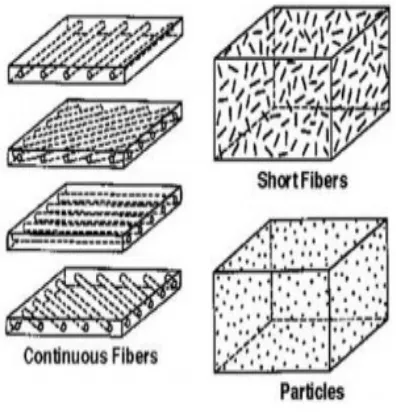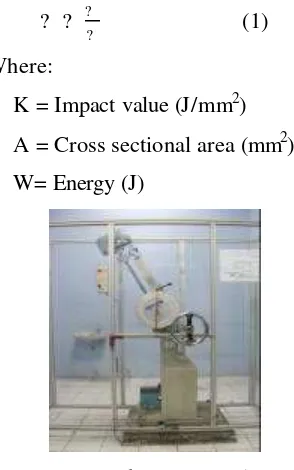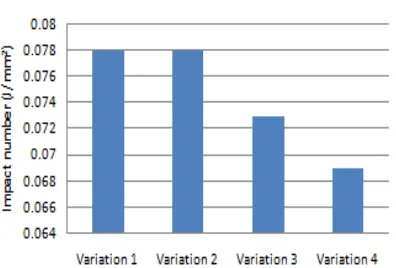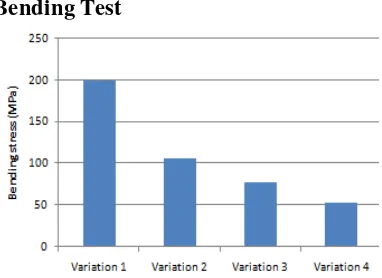THE EFFECT OF CATALYST WITH RESIN 157 BTQN ON
THE STRENGTH OF MOTORCYCLE BODY FIBER
MODIFIED
PUBLICATION ARTICLE
Arranged By: Kautzar Rizki Diptaseptian
D 200090201
MECHANICAL ENGINEERING DEPARTMENT
INTERNATIONAL PROGRAM
IN AUTOMOTIVE/MOTORCYCLE ENGINEERING
MUHAMMADIYAH UNIVERSITY OF SURAKARTA
VALIDATION SHEET
This Final Project by the title “THE EFFECT OF CATALYST WITH RESIN 157 BTQN ON THE STRENGTH OF MOTORCYCLE BODY FIBER MODIF”, has been approved by supervisors and authorized by Secretary of International Program as partial fulfillment of the requirements for getting Bachelor Degree of Engineering in Automotive Department of Muhammadiyah University of Surakarta.
Written by:
Name : Kautzar Rizki Diptaseptian NIM : D 200 090 201
Has approved and legalized on:
Day :
Date :
Supervisor I Supervisor II
(Ir. Pramuko IP, MT.) (Wijianto, ST.M.Eng.Sc)
Admitted by,
Secretary of International Program
4
THE EFFECT OF CATALYST WITH RESIN 157 BTQN ON THE STRENGTH OF MOTORCYCLE BODY FIBER MODIFIED
Ir. Pramuko IP, MT.
Mechanical Engineering Department of Muhammadiyah University of Surakarta Jln. A. Yani Pabelan-Kartasura. Tromol Pos I Telp. (0271) 715448 Surakarta
Wijianto, ST.M.Eng.Sc
Mechanical Engineering Department of Muhammadiyah University of Surakarta Jln. A. Yani Pabelan-Kartasura. Tromol Pos I Telp. (0271) 715448 Surakarta
Kautzar Rizki Diptaseptian
Automotive Engineering Department of Muhammadiyah University of Surakarta Jln. A. Yani Pabelan, Kartasura, Tromol Pos I, Telp. (0271) 715448 Surakarta
Email: [email protected]
ABSTRACT
Currently, many demands from consumers or motorcycle fans to have a motorcycle with good looking or appear attractive and make their motorcycle body are modified as they want. Fairly easy and quick to make is one benefit of this body modification that made by 3 main materials (resin, catalyst and fiberglass). A catalyst is a substance that can speed up the reaction towards equilibrium. The more the composition of catalyst, the less time is required to react. The objective of this study is to determine the effect of catalyst on the strength of material.
Testing is done by changing the catalyst composition in 4 variations (2.5%, 5%, 10%, and 20 %) of resin 157 BTQN. Each variation is tested by impact test that based on ASTM D-256, bending test that based on ASTM D-790 and tensile test that based on ASTM D-638. Analysis is conducted after got data of testing result.
The result of the testing of each variation has different strength (mechanical properties) that influenced by catalyst. The highest number of impact was got from variation of 2.5 % catalyst by 0.078 J/mm2, bending stress from 2.5% of catalyst by 199.86 MPa, ultimate tensile strength from variation of 5% by 76.64 MPa and modulus young from variation of 2.5% by 81.15 kg/mm2. The ability to withstand the force and the mechanical properties such as ductility, stiffness, hardness etc can be determined by the data gotten from the test result.
Key words: catalyst, fiberglass, resin, body fiber, impact, bending, tensile.
Background
Composite is a material that formed from a combination of two or more materials, where the materials mechanical
properties are different. Motor body is an example of a composite that is common and seen daily. Currently, many demands from consumers or motorcycle fans to
2
have a motorcycle with good looking or appear attractive and make their motorcycle body are modified as they want. There are many modifications in the automotive field, one of them in modifying the vehicle body (motor). Fairly easy and quick to make fans of motorcycle racing to change the look of their vehicles in order to become more attractive. Manufacture of fiber body material is relatively easy to form glass fiber, resin and catalyst.
In this study the authors will conduct a research on how much the catalyst will influence on the mechanical properties of this composite by volume fraction about 2.5%, 5%, 10% and 20%. The process to be conduct is given the composition of catalyst on resin in 4 different ratios then same condition of fiberglass and the room temperature to dry the mixture of it. Then the next is analyzing the result after testing and will get the comparison between each composition of catalyst.
Problem Statement
The problem statement that can be drawn from the problem above is how the catalyst can influence the mechanical properties of motorcycle body modification on impact strength, bending stress and tensile strength.
Objectives
Objectives of this research are as follow:
1. Know the influence of the catalyst in the manufacture of composite with different composition.
2. Analyze the composite (motor body) strength based on the amount of catalyst.
3. Producing the good quality of composite that can be used in the motor modification.
Problem Limitations
Scope area of this final project contains:
1. The main material used in the form is resin 157 BTQN, catalyst and fiberglass.
2. The catalyst variations are 2.5%, 5%, 10% and 20% of resin in composite manufacturing.
3. Specimens will be tested by impact, bending and tensile test.
4. Drying specimen is done at room temperature.
Basic Theory
Composites are created by
combining two or more materials to
produce a new material that retains
important properties from the original
components. These unique combinations
deliver significant advantages over
traditional materials in a wide variety of
structural applications. Composites consist
of a matrix material that is then reinforced
with fibers that can be taken from
ceramics, metals, or polymers. The
reinforcing fibers are the primary load
carriers of the material, w ith the matrix
component transferring the load from fiber
to fiber.
Figure 1 Composites
For manufacturers, composites offer
a flexible solution with the advantage of
being able to select just the right
combination of fiber reinforcement and
resin material to meet both the application
and property requirements of a finished
part.
Catalyst
A catalyst is any substance that works to accelerate a chemical reaction. It can be organic, synthetic or metal. The process by which this substance speeds up or slows a reaction is called catalysis.
Figure 2 Catalyst
For any process to occur, energy, known as activation energy is required. Without the help of a catalyst, chemical reactions might never occur or take a significantly longer period of time to react. When the chemical reaction occurs, the catalyst itself is not changed and is not part of the end result.
Figure 3 Comparison of catalysis and non-catalysis
Resin 157 BTQN
Polyester resin is unsaturated resins formed by the reaction of basic organic acids and polyhydric alcohols.
Polyester resins are used in sheet moulding compound, bulk moulding compound and the toner of laser printers. Wall panels fabricated from polyester resins reinforced with fiberglass
called fiberglass reinforced plastic (FRP) are typically used in restaurants, kitchens, restrooms and other areas that require washable low -maintenance walls.
Figure 4 Resin 157 BTQN
Polyester resins are thermosetting and as with other resin, cure exothermically. The use of excessive catalyst can, therefore, cause charring or even ignition during the curing process. Excessive catalyst may also cause the product to fracture or form a rubbery material.
Fiberglass
Fiberglass or fiberglass also called glass reinforced plastic (GRP), glass fiber reinforced plastic (GFRP) is made of a plastic matrix reinforced by fine fibers of glass. It also known as GFK (German: Glas Faserverstärkter K unststoff).
Fiberglass is a lightweight, extremely strong, and robust material.
Although strength properties are somewhat lower than carbon fiber and it is less stiff, the material is typically far less brittle, and the raw materials are much less expensive.
Figure 5 Fiber Glass (mat)
Fiberglass really is made of glass, similar to windows or the drinking glasses in the kitchen. The glass is heated until it is molten, then it is forced through superfine holes, creating glas s filaments that are very thin, so thin they are better measured in microns. For some applications, it is important for the glass fibers to have fewer impurities, which involves additional steps in the manufacturing process.
Impact Test
One of the most common tests of the physical characteristics of plastic materials is the notched izod impact test as specified by ASTM D 256 Standard Test Method for Determining the Izod Pendulum Impact Resistance of Plastics.
? ? ?
? (1)
Where:
K = Impact value (J/mm2) A = Cross sectional area (mm2) W= Energy (J)
Figure 6 Impact Tool Bending Test
Measure the width and thickness of the specimen including the span length in the table provided for the calculation of the stress and elastic modulus. Mark on the locations where the load will be applied under three -point bending.
Figure 7 Bending Tool
?? ? ? ? ? ? ?
?? ? ? ?? (2)
Where:
sb = Bending Stress (MPa)
P = Max Load (N)
L = Distance between supporter (mm)
b = Width (mm) d = Thick (mm) Tensile Test
Measure and record specimen dimensions (diameter and gauge length) in a table provided for the calculation of the engineering stress and engineering strain.
? ? ??
? (3)
Where:
E = Modulus elasticity (kg/mm2)
su = Ultimate Stress (MPa)
e = Strain
Figure 8 Tensile tool
6
Flow Chart of Research
Figure 3.1 Flow Chart of Research Start
Study cases and field
Material preparation and tools
Analysis System
a. Making process b. Curing time
Yes
Material mixture
a. (2.5% from resin) catalyst + Resin + a sheet of fiber glass
b. (5% from resin) catalyst + Resin + a sheet of fiber glass c. (10% from resin) catalyst + Resin + a sheet of fiber glass d. (20% from resin) catalyst + Resin + a sheet of fiber glass
Testing
a. Impact Test (ASTM D256) b. Bending Test (ASTM D790) c. Tensile Test (ASTM D638)
Result, discussion and conclusion
End
7
Test Result and Analysis
Catalyst (%) a (°) W1 (J) ß (°) W2(J) A (mm2) K (J/mm2)
2.5 30 21 28. 58 1.66 22.10 0.078 5 30 21 29 1. 4 17.66 0.078 10 30 21 29 1. 4 19.65 0.073
20 30 21 29 1.4 20.29 0.069
Table 1 Impact Test Result
Catalyst (%) Width (mm) Thick (mm) sb (MPa) Pmax (N)
2.5 13.26 1.48 199.86 4.82
5 14.38 1. 6 105.61 5.62
10 13. 66 1.86 78.18 5.85
20 13.22 2.07 52.5 5.68
Table 2 Bending Test Result
Catalyst (%) su (MPa) e (%) E (kg/mm2)
2.5 61.05 7.5 81.15
5 76.64 10.5 72.98
10 72.22 10.9 66.47
20 64.46 11.2 57.55
Table 3 Tensile Test Result
Impact Test
Figure 9 Impact number of specimens with different catalyst content
number shows in variation 1 and variation 2 that has same value of impact 0.078 J/mm2, but the variation of 2.5% catalyst has higher number of absorbed energy by 1.7Joule.
Hardness can be defined according to the ability of material to absorb the energy. The tougher the more energy can be absorbed by the material. So the material of variation 1 that has catalyst consumption of 2.5% has the more hardness and toughness than others.
Bending Test
Figure 10 Bending stress of each specimen Variation 1 that composed by 2.5% catalyst produced 199.86 MPa of bending stress, 5% catalyst produced 105.61 MPa, 10% catalyst produced 78.18 MPa and variation 4 that composed by 20% catalyst produced 52.5 MPa of bending stress. Tensile Test
The Figure 11 shows that variation 1 has 60.75 MPa in the ultimate stress and 81.15 kg/mm2 in modulus elasticity, variation 2 has 76,64 MPa and 72,48 kg/mm2, variation 3 has 72.22 MPa and
66.47 kg/mm2, variation 4 has 64.46 MPa and 72.44 kg/mm2.
Figure 11 Ultimate stress of each specimen.
From those testing can be concluded that 2.5% catalyst consumption (variation 1) has the best ability to suffer the forces that come suddenly, whereas this condition meet because the less catalyst the more energy can be absorbed by the material. It’s showed by the highest number of impact. The elongation was mean by how ductile the material has, so variation 3 (10% catalyst) is the most ductile that has strain number of 10.9% and the variation 1 is the most brittle, showed by the highest number of young modulus also has the good hardness. The bending stress indicates how brittle the material, so variation 1 has the better properties.
Variation 1 has the slowest process that is about 72 minutes. This curing time has effect on the molecules, increasing temperature by added more catalyst make the molecules move continuously and rearrange resin molecules so the hole used
2
to be on the surface and inside the composite will decrease, a little and after cooling the molecules move slower so this can improve the mechanical characteristic. Conclusion
From the result that has been tested before, we can take same conclusion that can be discussed and concluded as follows:
1. Catalyst consumption can influence the physical pr operties of material, where as this substance works as accelerate (speed up or lowers) the chemical reaction. So, less catalyst will need more time to finish the process but will give better characteristic of material.
2. The result of impact test that used ASTM D-256 shows the value of impact strength on each variation. In this test, absorbed energy as the ability of material was very important that could influence the value of impact number. The less catalyst consumption the greater material will gain the strength. From bending test of each variation that used ASTM D-790 given data or showed bending stress and also the capacity to suffer or hold the load that can bend the material. Tensile test of this study used ASTM D-638 and the result of each variation shows about ultimate stress, strain
and modulus elasticity. The strain was the number of elongation and means the ductility. So the entire specimen called by ductile cause those has passed the minimum value (5%).
3. According to those testing can be concluded that variation 1 has better characteristic about hardness, brittle, although it has the lowest value of elongation but this was pass or meet the condition to be called by ductile. So this variation has characteristic in the manufacturing of material that based on the strength and ductile. After conducting those some of testing, we have known that the physical properties of material can be manipulated by many ways, and this was one ways to do that (ratio of catalyst in resin).
Further Work
After conducting the analysis and testing, author pleasant to suggest some suggestion in order to make the better further:
1. Use the ideal composition of catalyst to get the best properties of composite and prevent of unexpected damage.
2. Preparing the material and tools as well as possible to make better result and get homogeneous condition.
3
3. May the further research can develop the studies by the types of fiberglass effect.
BIBLIOGRAPHY
Athallah. M, Ardhyananta. H, Pengaruh Jenis Katalis Terhadap Kekuatan Tarik dan Stabilitas Termal Polidimetilsiloksan untuk Lapisan Pelindung Baja AISI 1050, jurnal Teknik Pomits Vol. 2, No. 1, 2013
Karyono. Tri, Fiber Glass/ Polyster Resin, [email protected]
Lokantara, I, Putu, jurnal Analisa Kekuatan Impact Komposit,
Dinamika Teknik Mesin Vol. 2 No. 1, 2012.
Nurudin Arif, Sonief A Achmad, Atmodjo Y Winarno, Karakterisasi Kekuatan Mekanik Komposit Berpenguat Serat Kulit Waru Kontinyu Laminat dengan Perlakuan Alkali Bermatriks Polyester, Jurnal rekayasa mesin Vol.2, No. 3, Tahun 2011.
Suardia. T, Saito. S. Ilmu Pengetahuan Bahan Teknik, Pradnya Paramita Jakarta, 1985.
Salim, Analisa Kekuatan Tarik dan Bending Komposit Serat Benang Kapas dengan Menggunakan Perekat Resin Polyester,
Politeknosains vol.X no.2, 2011.
Setyawan D Paryanto, Sari H Nasmi, Putra P.G Dewa, Pengaruh Orientasi dan Fraksi Volume Serat Daun Nanas Terhadap Kekuatan Tarik Komposit Polyester Tak Jenuh, Dinamika Teknik Mesin, Volume 2 No.1, Januari 2012
Schwartz, M.M., 1984, Composite Materials Handbook, McGraw-Hill Book Co.New York.
Van Vlack. LH, 1994, terjemahan Japrie . S, Ilmu dan Teknologi Bahan , Edisi kelima, Erlangga, Jakarta http://www.jaist.ac.jp
Waigaonkar S, Babu B.J.C, Rajput A, Curing Studies of Unsaturated Resin Used in FRP Product, Journal, 2011.





